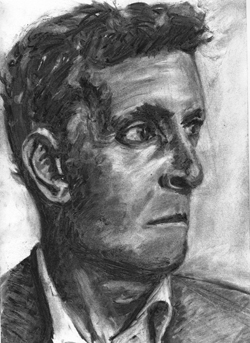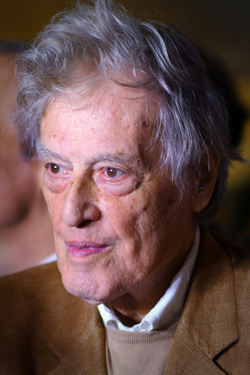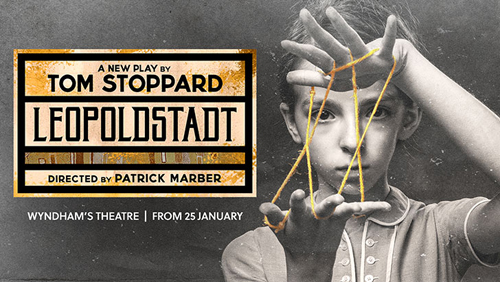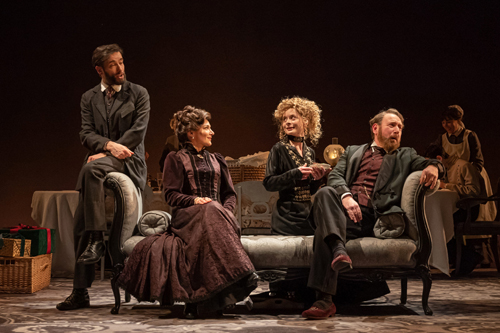
Your complimentary articles
You’ve read one of your four complimentary articles for this month.
You can read four articles free per month. To have complete access to the thousands of philosophy articles on this site, please
Theatre
Wittgenstein: Stoppard’s Muse
Fergus Edwards finds Wittgenstein everywhere in Tom Stoppard’s plays, from Jumpers to Leopoldstadt.
Sir Tom Stoppard (b.1937), full-time playwright, no-time university student, discovered philosopher Ludwig Wittgenstein’s work in July 1968. He wrote to his old flatmate that, rather than writing his next play, he was “following Wittgenstein through [the] Tractatus Logico-Philosophicus.” We know that he kept reading, because three years later his play Dogg’s Our Pet (1971) began with a deliveryman walking onto the stage and calling out for a ‘Block!’ and a ‘Slab!’ The whole scene is lifted directly from Wittgenstein’s Philosophical Investigations (1953). Even when Stoppard developed the material into a longer, more political play, Dogg’s Hamlet, Cahoot’s Macbeth (1979), he kept all the original Wittgensteinian references.

Wittgenstein by Athamos Stradis
Stoppard wrote his first play about a professional philosopher the following year. Jumpers (1972) follows Professor George Moore as he fails to write a speech supporting the existence of moral absolutes and of God. This is not, of course, the George Moore, famous moral philosopher: the in-joke is precisely that the name doesn’t adequately refer to the person.
In the play, the character George reminisces about Wittgenstein asking a colleague what the sky would have looked like if the Earth and not the Sun were the centre of the Solar System. Words fail the other academic, who can only gesture in reply. Literary scholars spotted that Stoppard was recycling material from an unproduced screenplay, Galileo. They didn’t recognise that the anecdote was lifted straight out of G.E.M. Anscombe’s An Introduction to Wittgenstein’s Tractatus (1959).

Sir Tom Stoppard in 2022
Tom Stoppard by Philip Romano 2022 Creative Commons
Jumpers also provided proof, were it needed, that Wittgenstein is funnier than Spinoza. In early performances, George called the police and gave a false name: ‘Spinoza’. No laugh. So Stoppard changed the pseudonym to ‘Wittgenstein’. Laughter ensued, problem solved.
Before the decade was out, Stoppard had written a whole colloquium of philosophers. In his TV play Professional Foul (1977) he sent a bunch of them to a conference in Prague, where their pristine ethical constructs were sullied by practical experiences of communist totalitarianism. The Professor of Ethics from Cambridge University concludes his speech with a Tractatus echo and inversion: “Whereof we cannot speak, thereof we are by no means silent…”
All this direct reference might seem rather brutal work for a muse. Wittgenstein’s influence on Stoppard is frequently more subtle. Consider the radio play Artist Descending a Staircase (1972). Before blindness takes over, Sophie falls in love with an artist she sees standing by his painting of black railings in the snow. After a long and unhappy relationship, it turns out that the exhibition also featured a painting, by a different artist, of a white fence on a black background. We never find out which painting Sophie actually saw. A philosopher in the audience may be reminded here of Wittgenstein’s Investigations, with its white cross on a black background and its black cross on a white background, which are, of course, the same figure.
Still too blunt? Well, there are no philosophers in The Real Thing (1982). There are playwrights, actors, and a famous speech comparing a well-written oration to a well-made cricket bat, “so that when we throw up an idea and give it a little knock it might… travel.” Its opening scene of marital infidelity turns out to be from a play set within Stoppard’s own play. The name of the inner play? House of Cards. An echo, perhaps, of Philosophical Investigations’ self-declared statement of intent: “What we are destroying are only houses of cards, and we are clearing up the grounds of language on which they stood.”
We can, perhaps, stretch the Wittgensteinian connections even further – at least as far as the character of Kerner in Stoppard’s play about Cold War spies, Hapgood (1988).
It might be unsurprising that in the normal course of business, Stoppard came to know several philosophers who had themselves known Wittgenstein. He met A.J. Ayer after Ayer’s positive review of Jumpers for the Sunday Times. Stoppard’s introduction to Stephan Körner was a little less predictable, and far more prosaic. Körner, a Czech refugee like Stoppard himself, had studied under Wittgenstein at Cambridge, and went on to senior roles at the Universities of Bristol and Yale. Yet Stephan only met Tom because they shared an accountant: Peter Stoppard, Tom’s older brother. It seems at least plausible, then, that the clever, decent, triple-agent of a quantum physicist in Hapgood is another link to Wittgenstein.
Where we might need to squint a little harder to see the Wittgensteinian muse, is in the 1972 TV show Tom Stoppard Doesn’t Know. Stoppard wrote a script in which he finds himself pestered by a journalist constantly asking for his comments on the moral questions of the day: apartheid, abortion, censorship, Vietnam: right or wrong? Stoppard repeatedly answers that he simply doesn’t know, and that he refuses to offer an illegitimate pretence of certainty. The one thing he does know however, is that the M4 is the fastest way to drive home. This is all very reminiscent of Wittgenstein’s Lecture on Ethics (1929), where we learn a surprising amount about the right road to Grantchester in Cambridge, but are also encouraged to accept the fundamental unknowability of ethical demands. Had Wittgenstein taken the M4, the history of ethical philosophy might have been very different. As would the history of the British motorway system, of course.
The final scene of Tom Stoppard Doesn’t Know takes place in the London Library. Thirty years after filming, in 2002, Stoppard would become President of the Library – a post he would hold for fifteen years. But in 1972 he arranged to be filmed in the Library’s ‘W’ section, telling us what he doesn’t know. As The Guardian’s film critic Michael Billington spotted, that meant that, there in the background, were the works of Wittgenstein.

Stoppard turned eighty-five last April, and he’s still writing. His most recent play, Leopoldstadt (2020), stages increasingly anxious scenes from the life of a wealthy Viennese family of Jewish heritage, in 1899, 1924, and 1938, before a visceral concluding scene set in 1955. Reviewers spotted here moments drawn from Stoppard’s past: a doctor stitching a child’s cut hand; an aunt disclosing the full extent of the family’s Jewish heritage and its terrible Holocaust losses. But while seeing those threads, the reviewers didn’t observe the Wittgensteinian fabric, including a family of wealthy Viennese industrialists who thought their distant Jewish heritage was beyond politics until it was almost too late; a brother who lost the use of a limb in the First World War; a sister who was painted by Klimt; and the gifting of Klimt’s painting, Philosophy, to the World’s Fair when it was rejected by its commissioners at the University of Vienna. All this is drawn directly from Wittgenstein’s family history.

Scene from a production of Leopoldstadt
A muse is more than a co-author, a source, an allusion, a reference point, a character or a punchline, of course. But if there is a presiding genius hiding in Stoppard’s work, then surely it is Ludwig Wittgenstein.
© Fergus Edwards 2023
Fergus Edwards is a PhD student at the University of Tasmania.









